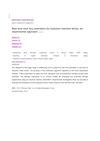New Approach-based MPP Tracking Design for Standalone PV Energy Conversion Systems
IF 0.9
4区 工程技术
Q4 ENGINEERING, ELECTRICAL & ELECTRONIC
引用次数: 1
Abstract
In searching for a maximum power point (MPP) using a DC boost converter for photovoltaic (PV) energy conversion systems, we realised that the fast and accurate way to find the suitable duty ratio value is the core problem to enhance the energy conversion efficiency of the PV system. Under uniform irradiation, the panels will generate the same values, so they have only one peak on the P-V curve; conventional MPP tracking methods easily obtain this MPP. However, under partial shading conditions, many peaks are created, traditional MPP tracking methods can fall into the local MPP, and this issue will cause energy loss and reduce PV energy conversion efficiency. To avoid this disadvantage, this paper proposes a hybrid method (HM) by combining the improved chicken swarm optimisation (CSO) method and the incremental conductance (InC) algorithm for a DC standalone PV energy conversion system. In this hybrid method, the improved CSO modified approach is used to search the global region, and the InC algorithm is responsible for capturing the top of this global region. MATLAB simulation and experimental results were performed to demonstrate that the proposed method has achieved the global MPP under uniform solar irradiance and partial shadow effects.基于新方法的独立光伏能量转换系统MPP跟踪设计
在使用直流升压转换器为光伏(PV)能量转换系统寻找最大功率点(MPP)时,我们意识到快速准确地找到合适的占空比值是提高光伏系统能量转换效率的核心问题。在均匀照射下,面板将产生相同的值,因此它们在P-V曲线上只有一个峰值;传统的MPP跟踪方法很容易获得该MPP。然而,在部分遮光条件下,会产生许多峰值,传统的MPP跟踪方法可能会陷入局部MPP,这将导致能量损失并降低光伏能量转换效率。为了避免这一缺点,本文将改进的鸡群优化(CSO)方法和增量电导(InC)算法相结合,提出了一种用于直流独立光伏能量转换系统的混合方法(HM)。在这种混合方法中,使用改进的CSO修改方法来搜索全局区域,并且由InC算法负责捕获该全局区域的顶部。MATLAB仿真和实验结果表明,该方法在均匀太阳辐照度和部分阴影效应下实现了全局MPP。
本文章由计算机程序翻译,如有差异,请以英文原文为准。
求助全文
约1分钟内获得全文
求助全文
来源期刊

Elektronika Ir Elektrotechnika
工程技术-工程:电子与电气
CiteScore
2.40
自引率
7.70%
发文量
44
审稿时长
24 months
期刊介绍:
The journal aims to attract original research papers on featuring practical developments in the field of electronics and electrical engineering. The journal seeks to publish research progress in the field of electronics and electrical engineering with an emphasis on the applied rather than the theoretical in as much detail as possible.
The journal publishes regular papers dealing with the following areas, but not limited to:
Electronics;
Electronic Measurements;
Signal Technology;
Microelectronics;
High Frequency Technology, Microwaves.
Electrical Engineering;
Renewable Energy;
Automation, Robotics;
Telecommunications Engineering.
 求助内容:
求助内容: 应助结果提醒方式:
应助结果提醒方式:


